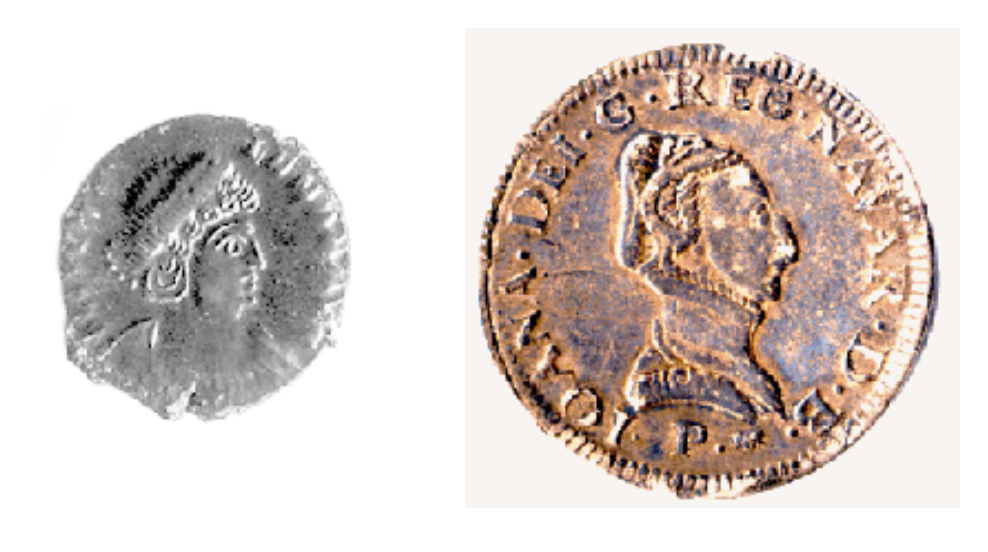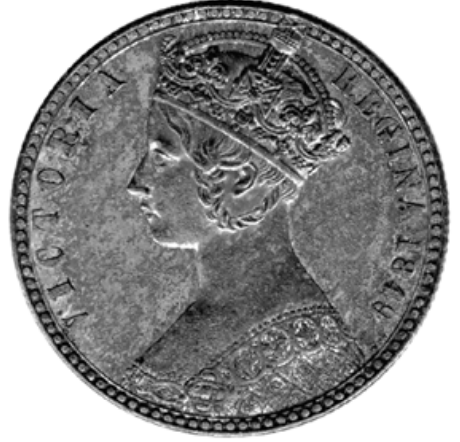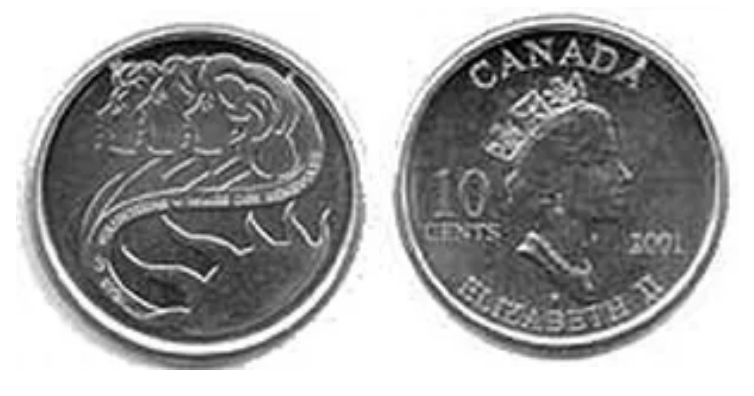Women and their Faith
By Geraldine Chimirri-Russell
Coins of Canada proclaim that Elizabeth II is Queen by the Grace of God - D[ei] G[ratia] REGINA. The claims of rulers to govern by the Grace of God have been made since the time of Charles the Bald of France (840 AD); they have been made in numerous states and nations and by representatives of different faiths.
There have been a number of women who have been closely associated with the promulgation or defense of the Christian Faith. St. Helena, the mother of Constantine the Great, was an early Christian who was influential in the nurturing of her son’s commitment to Christianity. It was Constatine who established Christianity as the religion of the Roman Empire. Helena was an enthusiastic Christian who founded churches in Jerusalem and Bethlehem and allegedly located the True Cross during her visit to the Holy Land. She appears on coins issued in her son’s reign. The reverses of her coins generally feature personifications such as Pax (Peace), or Securitas (Freedom from Danger), which do not necessarily reflect her religious convictions.
Women become embroiled with religious issues during the Reformation period. Challenges were made to the established Catholic Church by a number of individuals, such as Martin Luther and Calvin. These reformers worked hard to convert princes and rulers, because the change of religion of the ruler, generally meant the change of religion of the state. Jeanne of Navarre was such a ruler. Her mother Queen Marguerite, sister of Francis I of France, was sympathetic to the new religion, but she remained a Catholic. Queen Jeanne converted to Protestantism in 1560, after which she made strident efforts to maintain a haven within her realm for the Reformed Church in France. These efforts were not ultimately successful. The religious wars and persecution in France virtually ceased with the accession of her son Henry to the French throne. Although raised as a Protestant, he shrewdly adopted the Catholic faith in the interests of national peace and personal power.
The reverse legend of Queen Jeanne’s silver teston of 1564, reads GRATIA DEI ID SVM QUOD SVM (I am what I am by the grace of God). This seems to define her attitude towards her faith and her duty as queen.
Follis of Helena c. 328 AD Teston of Joanna of Navarre, 1564
(Actual size: 17 mm) (Actual size: 29 mm)
In Britain, Elizabeth II retains and uses the title of Defender of the Faith, FID[ei] DEF[ensor], bestowed on her ancestor, Henry VIII by Pope Leo X ( October 11, 1521). This was a reward for his learned pamphlet in which he had proclaimed a profound devotion to the papacy. When Henry broke with the papacy, he was deprived of the title by Pope Paul III, but it was restored to the king by Parliament in 1544. The abbreviation Fid. Def. or the letters F.D. have appeared regularly on the coinage of British monarchs since George I.
Bimetalic two pound coin, Great Britain, 1998.
Actual size 28 mm.
In Britain the struggle between Catholicism and Protestantism seemed to be focused at times when there were queens on the throne. The establishment of a Reformed Church began with Henry VIII. His son Edward was raised as a Protestant. The sickly youth inherited the throne from his father and was persuaded to nominate his Protestant cousin Jane as his heir. There were no coins issued during her nine day reign.
Mary, the eldest daughter of Henry VIII, seized the throne from her cousin and immediately made efforts to bring her realm back to the Catholic Church. Although she initially showed toleration for the reformers, she became increasingly harsh and began a series of persecutions. The pace of change increased with her marriage to the most Catholic Spanish King, Philip II. Although the English would not officially allow Philip the title of King of England, coins show the queen facing her husband as equals and cited in Latin as King and Queen of England. There were many of her subjects who resented Philip’s influence over her and her efforts to link England strongly to the Catholic countries of Europe. These factors and her programme of religious persecution made Mary a very unpopular monarch. She earned the epithet, Bloody Mary.
Silver shilling of Mary I, 1555. Silver sixpence of Elizabeth I, 1562
Actual size 30 mm. Actual size, 24.5 mm.
On Mary’s death the throne passed to her sister Elizabeth. Elizabeth had been raised as a Protestant and her life had been in danger during her sister’s reign. She survived the religious persecutions and steadily brought the realm back to the Protestant faith with herself as the Head of the Church. Religious persecution continued to some extent during her reign, but now those who adhered to the Catholic faith were at risk.
Religious questions related to the monarch continued during the reign of the Stuarts. James II, although an avowed Catholic, married a Protestant, Ann Hyde, by whom he had two daughters. His second wife, Mary of Modena, was a Catholic, and when his son James was born it seemed likely that James II would make efforts to reinstate Catholicism by force. Efforts were made by the Protestant clergy to depose James. William of Orange, the Protestant cousin and husband of Mary, was induced to take the throne as her co-ruler. James fled to Ireland, but was defeated by William at the Battle of the Boyne. The religious unrest from this event reverberates in Ireland to the present day.
James II’s two daughters, Mary and Anne, became Queens in turn, and maintained the Protestant religion in England, despite challenges from their half brother, James, and his son, Bonny Prince Charlie. When Anne died without leaving any surviving children the throne passed to the Protestant George I of the German Hanoverian line.
Silver twopence maundy coin,
William and Mary, 1689. Silver shilling of Anne, 1702
Actual size, 14 mm. Actual size, 25 mm.
Queen Victoria was a Protestant who did not question her religious affiliations. However, when coins were struck in Britain during her reign without the Dei Gratia legend, there was an outcry against the "godless coins." This indicates the strength of religious feeling in the country.
Silver crown of Victoria, 1847.
Actual size, 39 mm.
Today Elizabeth II maintains a devout attitude towards her duty as the Head of the Church of England. Her son Charles has expressed a wish that the title Defender of the Faith be changed to Defender of Faith to reflect the monarch’s duty to protect the many faiths of his people.
The Royal Canadian Mint has just issued its latest 10 cent coin, the first circulating 10 cent coin in 34 years to be issued without the customary fishing schooner design.
This coin, issued in the United Nation’s International Year of Volunteers, utilizes the March of Dimes to represent the importance of grass-root volunteerism in Canada. In the 1950’s Marching Mothers went door-to-door to raise money for polio. Since the 1960’s the March of Dimes has been a fundraising campaign for adult services at the Society for Manitobans with Disabilities (SMD).
The choice of the 10 cent coin, with its obvious link to the March of Dimes Campaign, for this commemorative piece seems completely logical, but the selection has certain design implications. The symbolic rendition of the Marching Mothers on the reverse of the coin, plus the bilingual legend, has left no space for the customary "CANADA", date and denomination. This information has been transferred to the obverse of the coin and in so doing has left no room for the Queen’s familiar title of ELIZABETH II D. G. REGINA.
This omission has gone virtually unnoticed and unremarked upon in the general news media. This is a far cry from the uproar caused by the Godless coins of Queen Victoria in Britain in 1849, and George V in Canada in 1911. In 1935 the omission of Dei Gratia (by the Grace of God ) on George V’s Silver Jubilee Canadian dollar coin failed to cause outrage, and now the omission of the title on Elizabeth II’s 10 cent coin has caused no comment. Perhaps we recognize that commemorative pieces are special cases, also that there is the matter of expediency of design decisions. On the other hand perhaps it is the case that the vast majority of Canadians are simply unaware of the meaning of D.G. on their coins and the traditional statement of the faith of their monarch.
My thanks to Murray Weston for bringing this coin to my notice and for allowing me to reproduce this coin here.






